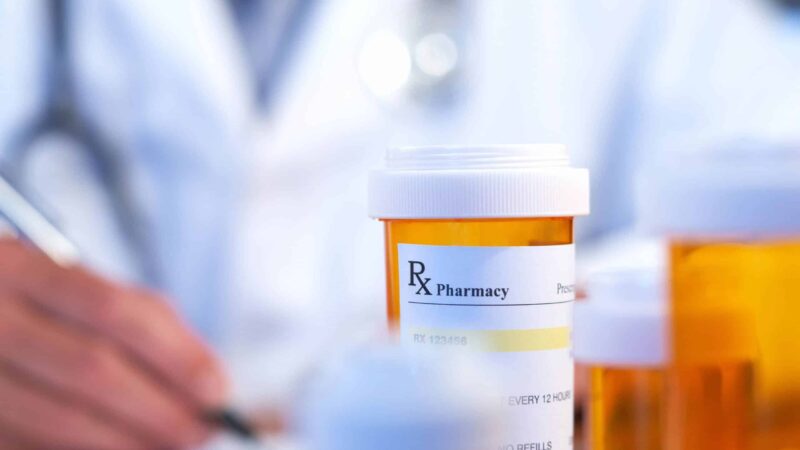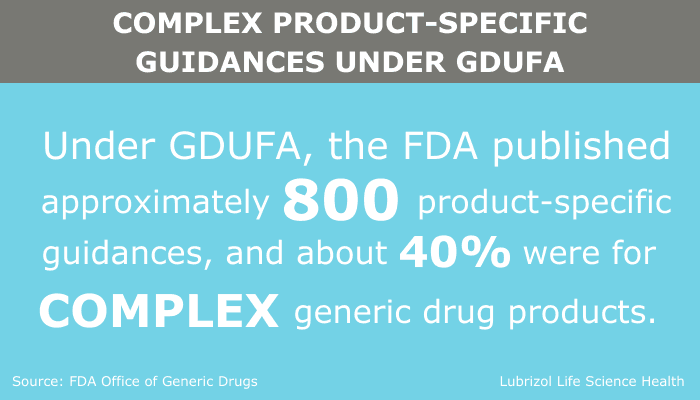6 Takeaways from the FDA’s Complex Generic Drug Product Development Workshop
Key Points
- Complex generic drug product development comes with challenging scientific and regulatory considerations, but the FDA is taking steps to simplify the process
- By publishing additional product-specific guidances and establishing a Pre-ANDA Program, the FDA has improved communication with ANDA applicants
- Q1/Q2 sameness and Q3 similarity requirements for complex ANDAs vary depending on the product and may include specialized characterization techniques
- The FDA is investing resources in modeling and simulation to help simplify bioequivalence evaluations and improve the complex ANDA application process
Why Host a Complex Generic Drug Product Development Workshop?
In September of 2018, the FDA hosted a two-day Complex Generic Drug Product Development Workshop. While the name doesn’t exactly roll off the tongue, the FDA organized this event to help simplify the development process and shed light on the need for generics in the complex drug product space.
Complex drug products are not only critical to the treatment of many serious medical conditions, but they are also valuable to the pharmaceutical industry. Multiple complex drug products have $1B+ markets (see Table 1 for examples of high-value complex drug products). Despite this, these products have little to no generic competition due to the complex scientific, legal, and regulatory challenges associated with complex generic ANDAs (see Table 1 for examples of high-value complex drug products). This is particularly concerning to the FDA because it has resulted in limited patient access for many of these drug products.
Table 1: High-Value Complex Drug Products
| Drug Product | Complex Product Type | 2017 Product Sales |
|---|---|---|
| Advair | Combination product | $4.3B |
| Victoza | Injectable peptide solution | $3.6B |
| Symbicort | Combination product | $3.1B |
| Restasis | Ophthalmic emulsion | $1.8B |
| Invega Sustenna | Injectable suspension | $1.8B |
| Sandostatin LAR | Injectable PLGA microspheres | $0.8B |
The FDA is working to simplify the path to market for complex generic drug products, as we addressed in a previous blog post. In this workshop, presenters focused on addressing the scientific challenges associated with characterizing and proving equivalence for products like liposomes, microspheres, and other complex formulations. If you couldn’t attend the workshop, here are six key takeaways from the presentations.
1. The FDA is Getting Specific with Complex Drug Products
The Generic Drug User Fee Act (GDUFA) was introduced in 2012 to create an evidence-, research-, and science-based standards setting program for the FDA. Since then, it has been a tremendous success story. Because of GDUFA, the Agency has been able to approve more ANDAs and provide better guidance for the development of future generic drug products. Under the program, approximately 800 product-specific guidances (PSGs) were published, and about 40% of those were for complex drug products. Before GDUFA, unclear regulatory expectations often led to incomplete ANDA applications and delays in complex drug product approvals. The Agency’s push to provide clarity on ANDA development requirements has generated more complete applications and helps reduce the number of review cycles required to obtain approval.
2. Communication is Key
As part of GDUFA II, the FDA has established the Pre-ANDA Program to facilitate discussions with the Agency around regulatory expectations for complex generic drug products. While PSGs have contributed to more complete ANDA applications, additional meetings are required for some complex generics. These meetings allow ANDA applicants to gain clarity when there isn’t a PSG available or when an applicant wishes to introduce alternative study approaches that are not covered in the PSG. There are three types of meetings that may occur:
- Product Development Meetings: Provide for discussion of specific scientific issues or questions, such as an alternative bioequivalence approach. Give applicants the opportunity to receive targeted advice from the FDA on their development plan and early stage data
- Pre-Submission Meetings: Provide an opportunity for prospective ANDA applicants to discuss and explain the format and content of the ANDA to be submitted. Allow the FDA to identify items or information that need further clarification before the submission takes place
- Mid-Review Cycle Meetings: Afford an opportunity for the FDA to discuss issues identified during review with the applicant.
“Pre-ANDA meetings allow ANDA applicants to gain clarity when there isn’t a product specific guidance available or when an applicant wishes to introduce alternative study approaches that are not covered in the product specific guidance.”
3. Q1/Q2 Sameness Is Not One-Size-Fits-All…
For certain types of drug products (parenteral, ophthalmic, otic), the FDA requires Q1 and Q2 sameness for generics. Q1/Q2 sameness may also be recommended in a PSG when in vitro methods for demonstrating bioequivalence are proposed. Their definitions are as follows:
- Q1 (Qualitative sameness): the test product uses the same inactive ingredient(s) as the reference listed drug (RLD)
- Q2 (Quantitative sameness): concentrations of the inactive ingredient(s) used in the test product are within +/-5% of those used in the RLD
Q1/Q2 sameness may be demonstrated with a formulation table showing the inactive ingredients and their quantities relative to an RLD. However, this approach is not always sufficient for complex generic drug products. Additional characterization may be required for complex excipients such as PLGA (see case study below).
Q1/Q2 Sameness Evaluation: PLGA-Based Drug Products
PLGA is used in 17 FDA-approved complex formulations, including microspheres, in situ forming gels, and implants. Despite this, there are currently no approved PLGA-based generics. One reason for this is that PLGA requires additional characterization to ensure Q1/Q2 sameness. Beyond a quantitative assessment, the PLGA in a generic drug product must be characterized using validated methods for composition (lactide/glycolide ratio), molecular weight and molecular weight distribution, polymer structure, inherent viscosity, glass transition temperature, polymer end-cap, and potentially other properties. If there are differences in these properties, the applicant must provide justification that the differences would not impact the safety or efficacy of the generic drug product as compared to the RLD.
4. …And Q3 Similarity May Be Necessary
While Q1/Q2 sameness provides a good starting point for matching the performance of an RLD, it is not always sufficient when it comes to complex generic drug products. For some complex ANDAs, Q3 similarity must also be considered:
- Q3 (Physicochemical similarity): the arrangement of matter (physical and structural properties) is similar to the RLD
Q3 similarity mitigates the risk associated with physicochemical variations in a generic drug product, including, but not limited to:
- Differences in the polymorphic form of a drug
- Differences in rheology
- Differences in crystallinity that can impact drug diffusion
When evaluating products such as ophthalmic suspensions and multi-phase creams, these physicochemical properties can have a significant impact on the performance of the generic drug product. As a result, many PSGs, especially those for topical ANDAs, recommend Q3 evaluations.
Solid State Characterization: The Key to Q3 Similarity Assessments
API quality has a direct impact on drug product development and manufacturing. Being able to reliably measure properties such as particle size distribution, polymorphism, and crystallinity are critical to the success of many complex ANDA programs. In order to effectively measure these properties, expertise in solid state characterization is required. There are many techniques in this space, including optical microscopy, XRD, differential scanning calorimetry (DSC), Fourier Transform infrared analysis (FTIR), and others. An understanding of solid state characterization can help ANDA applicants select appropriate analytical methods and troubleshoot problems that may arise with a solid drug substance or complex drug product.
5. Your Bioequivalence Approach Needs to be Robust
For demonstrating bioequivalence, in vitro release testing (IVRT) is critical to measure the rate and extent of dissolution or release of the drug substance from a drug product under a specific condition. For complex products, these methods should be reproducible, sensitive, and discriminating, allowing detection of changes in polymorphic form, physical structure, and other properties. Ultimately, a bioequivalence approach must be able to show how critical quality attributes and manufacturing process variation impact product performance, and IVRT is a valuable tool in achieving that goal.
Case Study
Case Study: Bioequivalence Evaluation of Exparel®
Exparel® is a liposomal formulation of bupivacaine that was approved in 2011. The FDA has published a PSG on Exparel® that outlines specific bioequivalence requirements for this complex formulation. The requirements include Q1/Q2 sameness for the liposomes, equivalent amounts of free and encapsulated drug, multiple measurements of the internal aqueous environment within the liposome, particle structure and morphology measurements (Q3 similarity), and IVRT that can “discriminate the effect of process variability in the production of the test formulation.” In order to achieve this final requirement, the IVRT method must be developed and validated around relevant experimental factors. For example, IVRT for liposomal products might evaluate the impact of factors such as:
- Temperature: changes the mobility of lipid chains
- pH: changes the ionization of the drug
- Agitation: causes disruption of liposomes
- Composition of the release media: causes disruption of liposomes
These experimental factors will vary depending on the formulation, but they help to validate the IVRT method, which is critical to a successful ANDA application. A robust IVRT study combined with Q1/Q2 sameness and physiochemical characterization (Q3 similarity) creates a comprehensive data package that follows the requirements of the PSG.
6. Modeling and Simulation Will Shape the Future of Bioequivalence Evaluation
Complex drug products introduce unique challenges in establishing bioequivalence. Locally-acting formulations may not be able to use plasma concentration as a surrogate for pharmacological activity, and long-acting formulations face high dropout rates in clinical trials due to long study durations. Because of these and other challenges, the FDA is investing in programs to develop modeling and simulation for bioequivalence evaluations. Models are being optimized for ophthalmic and dermal products that factor in permeability and transport within human tissue. These models pull from existing literature and FDA-funded studies to try and simulate how variations in the product and the patient impact drug delivery. Other studies attempt to correlate novel markers for drug delivery with long-term product performance to justify a shorter duration bioequivalence study or reduce the sample size associated with a clinical study. The FDA is willing to evaluate alternative bioequivalence approaches, and these requests are covered under Product Development Meetings in GDUFA II. Moving forward, the FDA hopes that universal modeling approaches can simplify bioequivalence evaluations and help ANDA applications progress more efficiently.
Conclusion
Complex generic drug product development comes with challenging scientific and regulatory considerations, but the FDA is taking steps to simplify the process. At the 2018 Complex Generic Drug Product Develop Workshop, the Agency addressed their efforts to improve communication with ANDA applicants and clearly laid out strategies for navigating the world of complex drug product development. From product specific guidances that contain detailed Q1, Q2, and Q3 requirements to investment in modeling and simulation software, the Agency has taken a proactive approach to improving the efficiency of the ANDA review cycle.
Although the Agency continues to work on an easier regulatory pathway, this doesn’t change the fact that formulating, characterizing, and manufacturing complex generic drug products remains uniquely challenging. To successfully develop a complex generic, you need a partner who can navigate complex APIs, formulations, dosage forms, routes of administration, analytical challenges, and manufacturing processes to meet the FDA’s requirements.
Authors:


